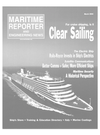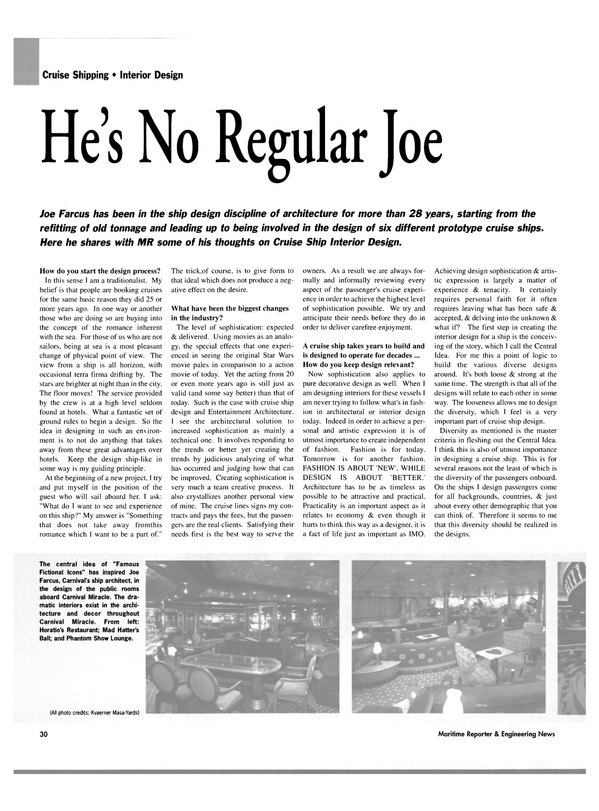
He's No Regular Joe
Joe Farcus has been in the ship design discipline of architecture for more than 28 years, starting from the refitting of old tonnage and leading up to being involved in the design of six different prototype cruise ships.
Here he shares with MR some of his thoughts on Cruise Ship Interior Design.
How do you start the design process?
In this sense I am a traditionalist. My belief is that people are booking cruises for the same basic reason they did 25 or more years ago. In one way or another those who are doing so are buying into the concept of the romance inherent with the sea. For those of us who are not sailors, being at sea is a most pleasant change of physical point of view. The view from a ship is all horizon, with occasional terra firma drifting by. The stars are brighter at night than in the city.
The floor moves! The service provided by the crew is at a high level seldom found at hotels. What a fantastic set of ground rules to begin a design. So the idea in designing in such an environment is to not do anything that takes away from these great advantages over hotels. Keep the design ship-like in some way is my guiding principle.
At the beginning of a new project, I try and put myself in the position of the guest who will sail aboard her. I ask: "What do I want to see and experience on this ship?" My answer is "Something that does not take away fromthis romance which 1 want to be a part of." The trick,of course, is to give form to that ideal which does not produce a negative effect on the desire.
What have been the biggest changes in the industry?
The level of sophistication: expected & delivered. Using movies as an analogy.
the special effects that one experienced in seeing the original Star Wars movie pales in comparison to a action movie of today. Yet the acting from 20 or even more years ago is still just as valid (and some say better) than that of today. Such is the case with cruise ship design and Entertainment Architecture.
I see the architectural solution to increased sophistication as mainly a technical one. It involves responding to the trends or better yet creating the trends by judicious analyzing of what has occurred and judging how that can be improved. Creating sophistication is very much a team creative process. It also crystallizes another personal view of mine. The cruise lines signs my contracts and pays the fees, but the passengers are the real clients. Satisfying their needs first is the best way to serve the owners. As a result we are always formally and informally reviewing every aspect of the passenger's cruise experience in order to achieve the highest level of sophistication possible. We try and anticipate their needs before they do in order to deliver carefree enjoyment.
A cruise ship takes years to build and is designed to operate for decades ...
How do you keep design relevant?
Now sophistication also applies to pure decorative design as well. When I am designing interiors for these vessels I am never trying to follow what's in fashion in architectural or interior design today. Indeed in order to achieve a personal and artistic expression it is of utmost importance to create independent of fashion. Fashion is for today.
Tomorrow is for another fashion.
FASHION IS ABOUT NEW'. WHILE DESIGN IS ABOUT BETTER.' Architecture has to be as timeless as possible to be attractive and practical.
Practicality is an important aspect as it relates to economy & even though it hurts to think this way as a designer, it is a fact of life just as important as IMO.
Achieving design sophistication & artistic expression is largely a matter of experience & tenacity. It certainly requires personal faith for it often requires leaving what has been safe & accepted, & delving into the unknown & what if? The first step in creating the interior design for a ship is the conceiving of the story, which I call the Central Idea. For me this a point of logic to build the various diverse designs around. It's both loose & strong at the same time. The strength is that all of the designs will relate to each other in some way. The looseness allows me to design the diversity, which I feel is a very important part of cruise ship design.
Diversity as mentioned is the master criteria in fleshing out the Central Idea.
I think this is also of utmost importance in designing a cruise ship. This is for several reasons not the least of which is the diversity of the passengers onboard.
On the ships I design passengers come for all backgrounds, countries, & just about every other demographic that you can think of. Therefore it seems to me that this diversity should be realized in the designs How do you balance your design with naval architecture and shipbuilding capabilities?
Advances in shipbuilding technology have mainly had a balancing effect on the rising cost of ship construction, which is due in this case to the market sophistication demands, safety issues and the cost which they create. At the end of the day, if the ship costs too much, then the passage price will raise to a point where the market will turn thin. Unfortunately, the design effect of this curtails creativity and design revolution.
In every project that I have been involved with, the initial most daring naval architecture creativity is always compromised in the final form of the ship. But this is a fact of life which slows revolution into evolution.
What will the Cruise Ship of the Future Be?
Questions about the future are best answered by the past, as it is the only guide post to which one may rely upon to give any insight into predicting what may come. 'Should,' is the key word to this future. The cost of ships today does not allow for mistakes in basic planning, therefore the ships which will come to be will be evolutionary rather than revolutionary.
I'm sure that owners would be happier believing that they are being shown a new design which should be built, rather than one which could be built.
What is the market that will steer the future?
Again, the past is the breeding ground in my opinion. If the past tells us anything, it tells us that the market wants more. If we look at the matriarchal ships which created cruising as we know it today, it is clear that what they have offered the market then, is the whale oil lamp version of the halogen light today.
Yet some of these veterans are still showing guests a good time, which demonstrates to me that the initial concepts which began the phenomenal growth of cruising are still pertinent today. What has happened is that those concepts have become sophisticated, from safety items, to decoration materials, to new concepts of ship designs, to ways to cook a thousand chickens better: it is dramatic. In my mind, the personal face of the market has always been a diverse group of people. This has played itself out in my work whereby I have very consciously and deliberately set out to create diverse and varied environments with and within all of the ships I have designed.
Read He's No Regular Joe in Pdf, Flash or Html5 edition of March 2004 Maritime Reporter
Other stories from March 2004 issue
Content
- Bollinger Delivers Tidewater Supply Boat Jonathan Rozier page: 8
- World's Largest Dry Transport Vessel Delivered page: 10
- Port security: A Historical Perspective page: 12
- Delayed Enforcement of Change to "Shipper" Element page: 16
- MTSA: Another Key Layer of Port Security page: 17
- When Security is Made Simple page: 20
- Business Milestone for Vietnam page: 24
- "Made in Germany1 — a New High page: 24
- Miracle on Ice page: 26
- New President & CEO at Kvaerner Masa-Yards page: 28
- He's No Regular Joe page: 30
- Cruise Passenger Travel Grows 8 Percent; New York and Galveston Post Big Gains page: 32
- HAL's Vista Sails with ROCHEM Technology page: 33
- Royal Caribbean Takes Mariner of the Seas page: 34
- NorseMerchant Ferries Plans Service Upgrade page: 37
- Grimaldi Continues Fast Track Expansion page: 38
- Costa Places $450m Order With Fincantieri page: 40
- Losing ontact... Not an Option page: 44
- Ship Security Alert Systems (SSAS) page: 50
- GALILEO Lifts Off page: 52
- Icebreaker Uses Satellite to Break Through Communications Barriers page: 55
- Cellular Fixed Wireless Helps Deliver Mercy page: 57
- Homing in on Ships' Electrics page: 58
- Shipconstructor Chosen as Standard page: 61
- Contract for New Product Tanker Design page: 62
- BollFilter: 50 Years of Success and Counting page: 65
- The Corrosion Control Challenge page: 66
- Nippon Paint Restructures page: 69
- Metal Fusion Helps Stop Corrosion page: 69
- Maritime Security Professional Training page: 72
- Training the Trainer to Keep Knowledge Afloat page: 74


